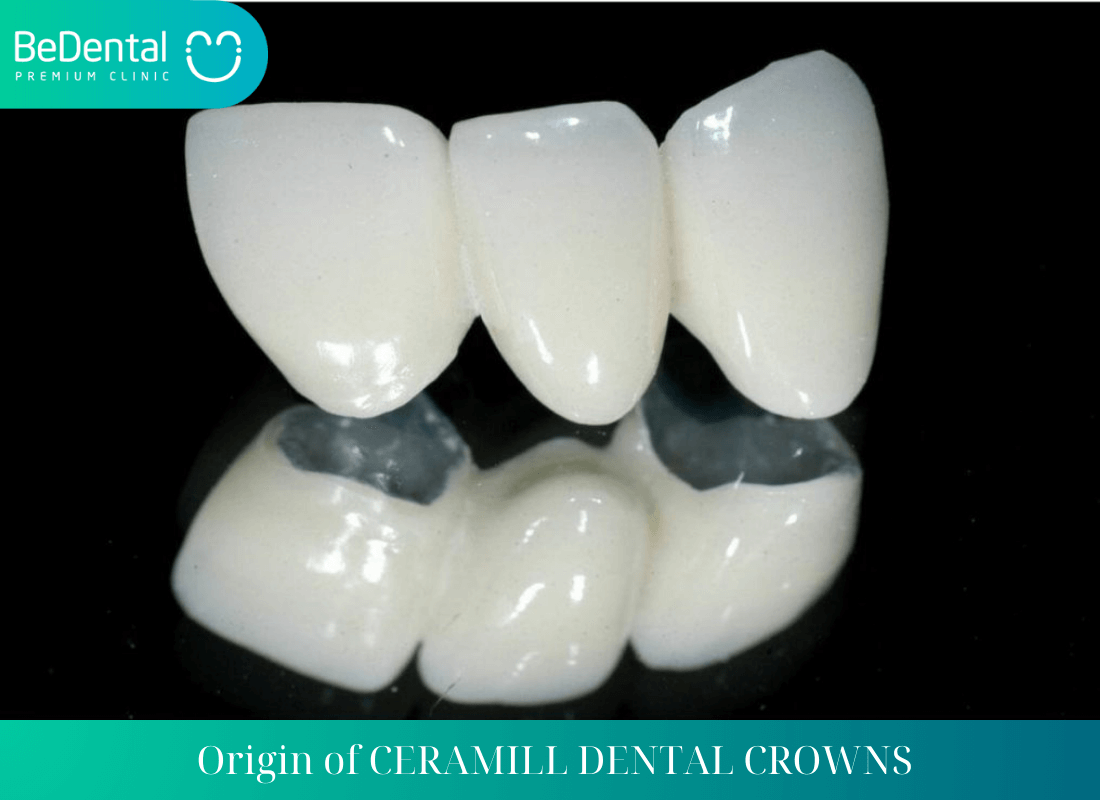What is a zirconia bridge ? Do I need to utilize it? What are Zirconia bridge’s advantages?If you have one or more missing teeth, you can have a hard time smiling or laughing around other people. Moreover, you can start chewing or notice an unexpected lisp or whistling when speaking. You should consider a bridge if missing teeth are interfering with your daily life. Zirconia bridge is one of the best choices. In this post, let’s learn more!
What is a dental bridge?
In order to replace one or more missing teeth, dental bridges join two teeth together around the area where the missing tooth once belonged. The adjacent tooth’s enamel will then need to be filed down by the dentist so that a crown can be placed on it and connected to the ceramic bridge.
Also, if you’ve lost several teeth, your dentist could first insert the implant before inserting the dental bridge. Bridges may be built from a wide range of materials, including metal, titanium, ceramic, and porcelain. Depending on the kind, strengths and qualities will change.
What is a Zirconia bridge?
Zirconia bridge is acknowledged as having the greatest quality bridge that is stable, durable, and aesthetically pleasing when compared to other forms of bridges. Because zirconia bridge doesn’t leave a dreadful gray line along the gum line and causes less tooth sensitivity issues than metal ceramic bridges, it is typically favored over them. For many individuals, this is a drawback of utilizing a bridge. Nevertheless, this can be avoided by using an all-ceramic bridge or the highly regarded zirconia bridge.
See more: Porcelain veneers: Where can you go for porcelain veneers in Hanoi and HCM city?
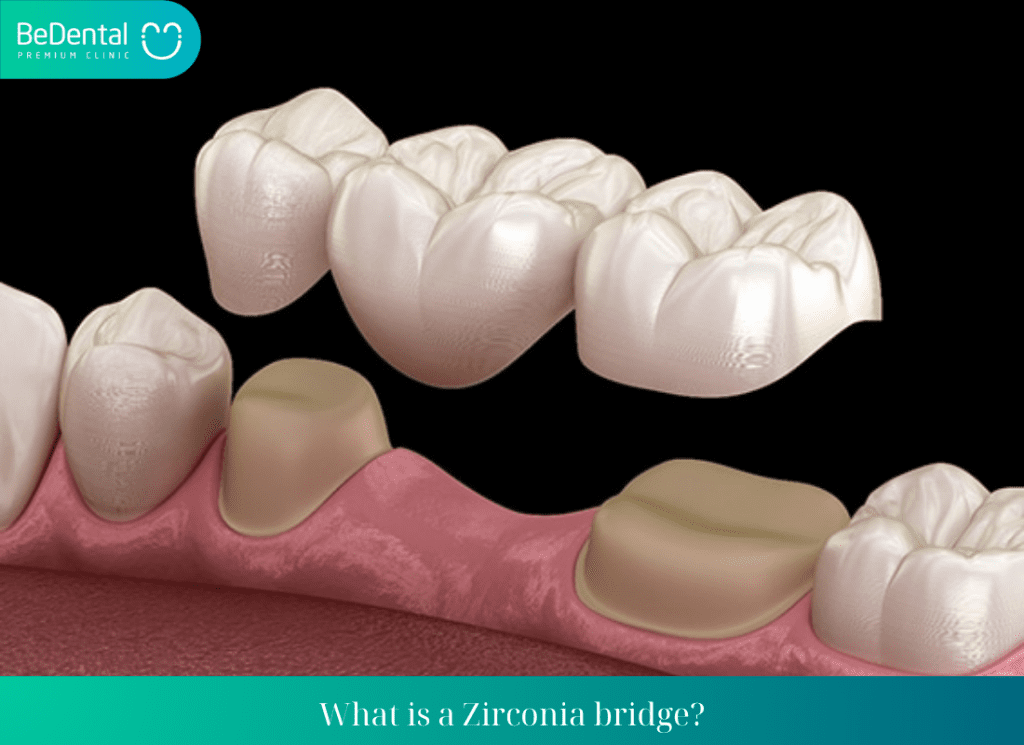
Zirconia bridge’s advantages
The kwy of Zirconia bridge’s advantages that is durable, aesthetically pleasing, and blends in with the rest of your teeth. This bridge’s construction material is “biocompatible,” which means it won’t harm any living tissue in your body or result in any unfavorable side effects like an allergic response. Moreover, there are some other advantages:
- Creates a real appearance that resembles or improves the original tooth
- Replaces a broken or cracked tooth to its original shape
- Replaces a missing one or more teeth or all teeth in the mouth
- Stronger than Porcelain rehabilitation
- Improves chewing capability
- Very useful for masking highly discolored teeth
- Indicated for patients with a history of grinding or clenching
- Low tooth wear of opposing teeth
- Less tooth extraction is needed for pure zirconia crowns
- Resists staining from coffee, tea, cigarette smoke, red wine, and more
- Straightens crooked teeth
- Closes minor gaps between teeth
See more: Zirconia veneer and 6 common concerns
Zirconia bridge’s disadvantages
The price of this bridge may be more than a typical metal-ceramic bridge, which is one downside. Although ceramic is a durable and long-lasting material, the crowns’ surface might eventually grow rough and scrape against surrounding teeth.
Dental bridge types
There are four main types of dental bridges:
- Traditional
- Cantilever
- Maryland
- Implant-supported
Dental bridge types: Traditional dental bridge
In a normal dental bridge, the false tooth or teeth are held in place by dental crowns that are cemented to each of the abutment teeth. The most common form of dental bridge is a conventional bridge, which can be utilized if you still have healthy teeth on either side of the gap left by your lost tooth.
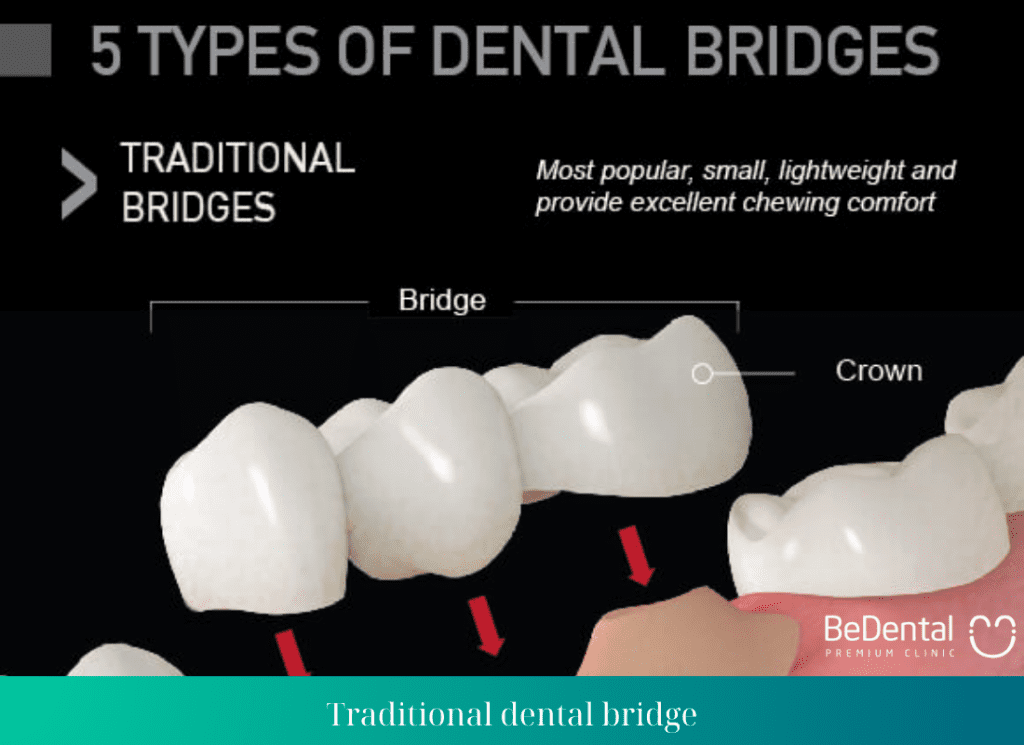
Dental bridge types: Cantilever dental bridge
Similar to traditional bridges, cantilever bridges use a single abutment tooth as the anchor for the pontic, which is fixed in place by a dental crown. A cantilever bridge can be supported by just one healthy tooth close to the space created by the missing tooth.
See more: Root canal treatment: 5 things that you wonder about
Dental bridge types: Maryland dental bridge
Like traditional bridges, Maryland dental bridges use two healthy teeth—one on either side of the gap—as the abutment teeth. A Maryland bridge employs a metal or porcelain framework that is bonded to the backs of the abutment teeth as opposed to a regular bridge, which puts dental crowns on the abutment teeth.
As a regular bridge, a Maryland bridge can only be used if there is a natural tooth on either side of the gap caused by the missing tooth or teeth.
Dental bridge types: Implant-supported dental bridge
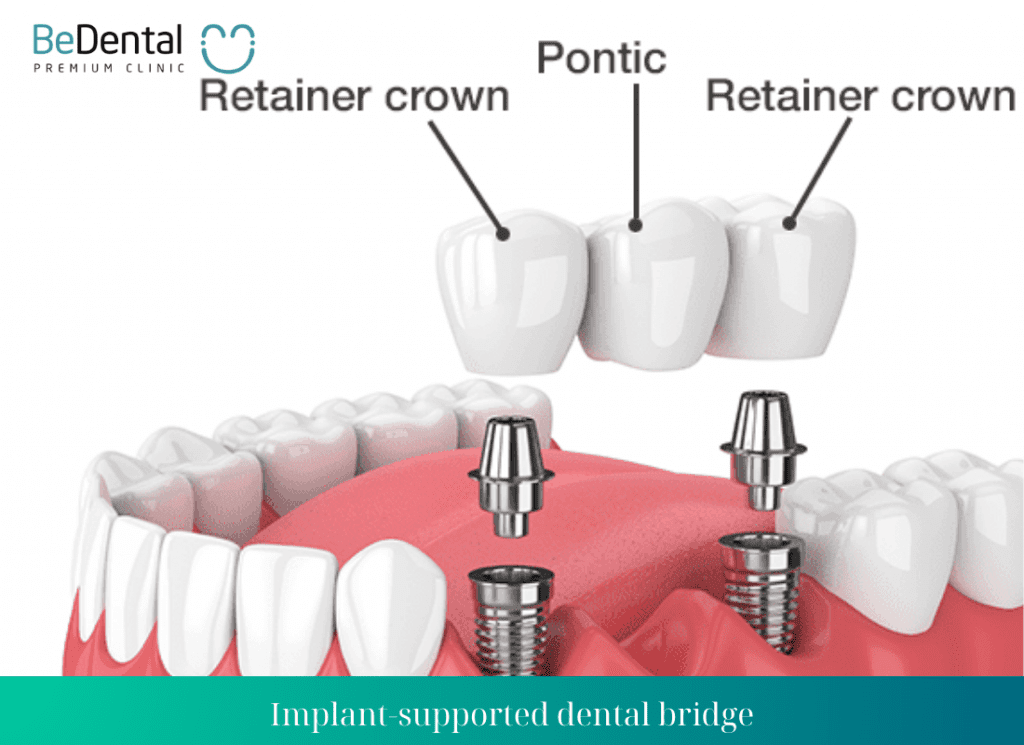
As the name suggests, dental implants serve as the foundation for implant-supported bridges rather than frames or crowns. Typically, one implant is surgically placed for each lost tooth, holding the bridge in place. A pontic can be connected between two implant-supported crowns if one implant for each lost tooth is not practical.
An implant-supported bridge, which is thought to be the sturdiest and most stable device, often requires two procedures:
- One to insert the implants in the jawbone
- A second surgery to place the bridge
It might take months to finish the procedure as a whole.
See more: Dentures and 2 types of dentures
Dental bridge vs Dental implant
A form of prosthetic device used to replace one or more missing teeth is a dental bridge. Metals like gold, silver, ceramic, or porcelain are typically used in their construction. Only a dentist is able to remove dental bridges, which are affixed to the teeth or an implant that fill the gap. This contrasts with detachable prosthetics like dentures.
The abutment is the part of a dental implant that holds a bridge in place. Abutments act as the bridge’s anchor points. The bridge that covers the abutments is then connected to the pontic, which performs the role of a replacement tooth. When a dental bridge is not attached to a dental implant, the teeth’s surfaces are often polished first to make them ready for the bridgework.
The three forms of dental bridges are traditional bridges, resin-bonded bridges, and cantilever bridges. The most typical style of bridges is the traditional one, and these are frequently built of porcelain attached to metal or ceramic components.
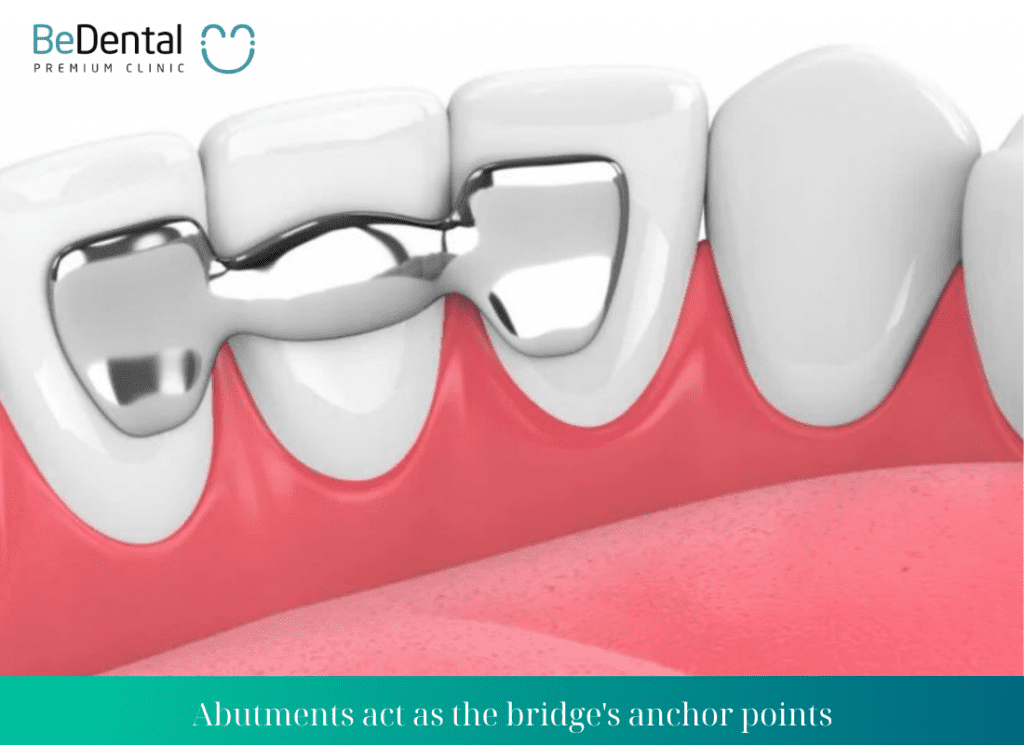
The most typical material used to make crowns and bridges is porcelain. It is made of a material that resembles teeth and may be painted to match the color of your natural teeth. Porcelain may be molded to resemble actual tooth enamel and provide a stable foundation for your bridge.
Dental porcelain is a durable type of bridge that, like sturdy, healthy teeth, can withstand everything you eat. Moreover, porcelain has a whiteness that is comparable to that of glass, reflecting light and giving the illusion of real tooth enamel. Porcelain dental bridges are a superior prosthesis due to their durability. Dental bridges made of porcelain are an easy and efficient technique to replace lost teeth.
The use of porcelain bridges is generally believed to be risk-free, however there are certain possible risks to be aware of. Have a consultation with your cosmetic dentist to find out the safety guidelines for the dental bridge procedure you’re thinking about.
See more: Zirconia Prosthetics Used to Treat Cavities and Tooth Sensitivity
What does a dental bridge cost?
There are a number of factors that could influence the cost, such as:
- Number of teeth needed to fill the gap
- Materials used, such as composite resin, zirconia, or metal
- Difficulty of the placement
- Additional treatments
- Geographic location
The price also changes depending on the bridge type you choose:
- One pontic and a crown for each abutment tooth are commonly included in traditional or cantilever bridge prices ranging from $2,000 to $5,000.
- Maryland bridges generally range in price from $1,500 to $2,500 for a single pontic with the wings linked to the abutment teeth.
- An implant-supported bridge could cost $5,000 – $15,000 for a bridge with two dental implants spanning three or four teeth.
Where can you have a dental bridge in Hanoi and HCM city?
Where can you have a dental bridge in Hanoi and HCM city? BeDental will be the best choice for those who want to experience the top-notch facilities and qualified dentist.After a short period of operation, the center quickly established itself as a popular destination for dental treatments and a leader in the area of dentistry.
BeDental is set to become the top dentistry facility in Vietnam, thanks to highly qualified dental specialists, cutting-edge technology, and cutting-edge equipment such as a 3D Scan CT scanner, Panorama and Cephalo X-ray machines, a laser teeth whitening system, and so on.
See more: Dental implants and Dental bridge
BeDental was established with the mission “Sow smile, spread success”, and believe that everyone deserves to have a charming and confident smile. That’s why Be tried their best to solve the dental problems or obstacles that hide your stunning smile.In reality, expenses are variable and rely on a variety of factors in a dental office, such as region, facilities, staff, service quality, brand awareness, technology, and so on.
BeDental has revised their price list as our facilities and technologies have improved over the last ten years of growth and development. They make certain that their fees are affordable and flexible to a variety of financial conditions.

Here is dental services price list at BeDental
Over 10,000 patients from oversea chose Bedental last year because we provide premium quality dental care at affordable fees and prices.
We do not provide the cheapest dental works in Vietnam as premium dental works cannot be offered at cheap price.
However, compared to the prices of dentists in US, UK, Australia and New Zealand….. you can expect to save up to 70% of the cost of dental treatments while getting the same level of quality. All products, materials and equipment are manufactured in the US, Japan or Europe. All of them are FDA and CE safety regulation compliant.
I.COSMETIC PORCELAIN CROWN PRICE LIST
| Category | Price | ||
|---|---|---|---|
| 1. Phục hình tháo lắp - (Tìm hiểu thêm...) Removable Denture (More detail...) | |||
| Giá Hàm nền nhựa thường Conventional Denture (More detail...) | (1teeth) | 4.000.000 | |
| Giá Hàm nền nhựa dẻo Flexible acrylic partial denture | (1teeth) | 5.500.000 | |
| Giá Hàm khung kim loại thường Cast metal partial denture | (1teeth) | 4.500.000 | |
| Giá Hàm khung Titan Titanium partial denture | (1teeth) | 6.000.000 | |
| 2. Răng giả (Tìm hiểu thêm...) False teeth | |||
| Giá Răng giả hàm tháo lắp nhựa nội Acrylic resin teeth -made in Vietnam | (1teeth) | 350.000 | |
| Giá Răng giả hàm tháo lắp nhựa Mỹ Acrylic resin teeth -made in USA | (1teeth) | 600.000 | |
| Giá Răng giả hàm tháo lắp sứ Porcelain teeth backed with metal | (1teeth) | 1.800.000 | |
| Máng nâng khớp Denture occlúion | 1.000.000 | ||
| 3. Phục hình cố định : Non-removable denture | |||
| Giá Sứ kim loại (Tìm hiểu thêm...) Porcelain teeth backed with metal | |||
| Giá Răng sứ kim loại thường (Ni,Cr) Porcelain teeth backed with metal (Ni,Cr) | 1.800.000 | ||
| Giá Răng sứ kim loại Vivadent france (Cr,Co) Porcelain teeth backed with metal Vivadent France (Cr,Co) | 1.800.000 | ||
| Giá Răng sứ kim loại Jelenko USA ( Cr, Co) Porcelain teeth backed with metal Jelenko USD (Cr,Co) | 2.000.000 | ||
| Giá Răng sứ kim loại titan Porcelain teeth backed with titanium | 3.500.000 | ||
| Giá Sứ không kim loại : (Tìm hiểu thêm) Non-metal Teeth | |||
| Giá Răng sứ Katana (bảo hành 7 năm) Porcelain Veneer Katana from Japan | 3.500.000 | ||
| Giá Răng sứ Venus ( bảo hành 7 năm) (Tìm hiểu thêm...) Porcelain Veneer Venus from Germany (More detail...) | 4.000.000 | ||
| Giá Răng sứ Roland ( bảo hành 10 năm) (Tìm hiểu thêm...) Porcelain Veneer Roland from Germany (More detail...) | 4.800.000 | ||
| Giá Răng sứ Roland HD (bảo hành 10 năm) (Tìm hiểu thêm...) Porcelain Veneer Roland HD from Germany | 5.900.000 | ||
| Giá Răng sứ Ceramill (bảo hành 10 năm)(Tìm hiểu thêm...) Porcelain Veneer Ceramil from Germany | 6.000.000 | ||
| Giá Răng sứ Emax Nanoceramics ( bảo hành 15 năm) Porcelain Veneer Emax from Germany | 7.000.000 | ||
| Giá Răng sứ HTsmile (Bảo hành 15 năm) (Tìm hiểu thêm...) Porcelain Veneer Htsmile from Germany (More detail...) | 7.000.000 | ||
| Giá Răng sứ Emax* Press Lithium Disilicate (Bảo hành 15 năm) (Tìm hiểu thêm...) Porcelain Veneer Emax press from Germany (More detail...) | 8.000.000 | ||
| Giá Răng sứ Cercon (Bảo hành 15 năm) (Tìm hiểu thêm...) Porcelain Veneer Cercon from Germany (More detail...) | 7.000.000 | ||
| Giá Răng sứ Nacera Pearl Shade ( bảo hành 10 năm) Porcelain Veneer Nacera from Germany | 10.000.000 | ||
| Giá Răng sứ Lava 3M Premium Plus ( bảo hành 15 năm) (Tìm hiểu thêm...) Porcelain Veneer Lava 3M Plus from USA (More detail...) | 9.000.000 | ||
| Giá Răng sứ Lava Esthentics ( bảo hành 15 năm) Porcelain Veneer 3M Lava Esthetic from USA | 12.000.000 | ||
| Giá Răng sứ Lisi Press (bảo hành 15 năm) (Tìm hiểu thêm...) Porcelain Veneer Lisi from Japan (More detail...) | 12.000.000 | ||
| Giá Răng sứ kim cương (Bảo hành trọn đời) Porcelain Veneer Diamond from USA | 16.000.000 |
II.DENTAL CARE TREATMENT PRODUCT PRICE LIST
| Service code | Category | Category | ||
|---|---|---|---|---|
| SP01 | Price of Kin Gingival 250ml (Kin mouthwash to treat gingivitis) | 180.000 | ||
| SP02 | Price of Kin Toothpaste 75ml (Kin toothpaste) | 180.000 | ||
| SP03 | Price of Kin B5 Enjuague 500ml (Kin daily mouthwash) | 310.000 | ||
| SP04 | Price of Kin B5 toothpaste 125ml (Kin b5 toothpaste) | 200.000 | ||
| SP05 | Price of Sensi Kin 250 (Anti-sensitivity mouthwash) | 250.000 | ||
| SP06 | Price of Sensi kin gel (Tube of topical anti-gingivitis medicine) | 180.000 | ||
| SP07 | Price of Perio kin (Gingivitis topical tube) | 180.000 | ||
| SP08 | Price of Ortho Kin 500ml (Orthodontic mouthwash) | 310.000 | ||
| SP09 | Price of Ortho Kin toothpaste (Orthodontic toothpaste) | 180.000 | ||
| SP10 | Price of Procare Water Flosser (Learn more......) | 1.850.000 | ||
| SP11 | Price of Oralpick Water Flosser (Learn more......) | 1.950.000 | ||
III.PERIODONTAL DISEASE TREATMENT PRICE LIST
| Service code | Category | Price | ||
|---|---|---|---|---|
| Lấy cao/vôi răng (Tìm hiểu thêm...) Tartar Cleaning and polishing (More detail...) | ||||
| NC01 | Giá Lấy cao/vôi răng độ 1 Tartar Cleaning and polishing - mild | 350.000 | ||
| NC02 | Giá Lấy cao/vôi răng độ 2 Tartar Cleaning and polishing - moderate | 450.000 | ||
| NC03 | Giá Lấy cao/vôi răng độ 3 - Tartar Cleaning and polishing - heavy | 600.000 | ||
| Dịch vụ khác Other dental Service | ||||
| NC04 | Giá Thổi cát cacbonat Cleaning with Cacbonat sand | 1.000.000 | ||
| NC05 | Giá Điều trị viêm quanh hàm (bao gồm máng + thuốc bôi) (Tìm hiểu thêm...) Operculectomy - Gumgivitis | 1.500.000 |
IV. DENTAL DISEASE TREATMENT SERVICE PRICE LIST
| Service code | Category | Price | ||
|---|---|---|---|---|
| 1. Giá Hàn răng (Tìm hiểu thêm...). Teeth filling (More detail...) | ||||
| DT01 | Giá Hàn/Trám răng sữa trẻ em Baby teeth filling | 250.000 | ||
| DT02 | Giá Hàn/Trám răng vĩnh viễn Permanent Teeth Filling | 500.000 | ||
| DT03 | Giá Hàn/Trám răng thẩm mỹ Cosmetic Filling | 700.000 | ||
| DT04 | Giá Hàn cổ răng Sensitive teeth filling | 500.000 | ||
| 2. Giá Điều trị tủy (Tìm hiểu thêm...) Root Canal Treatment - Anterior by endodontist machine (More detail...) | ||||
| DT05 | Giá Điều trị tuỷ Răng sữa Root Canal Treatment - Anterior for baby teeth | 800.000 | ||
| DT06 | Giá Điều trị tuỷ Răng cửa vĩnh viễn Root Canal Treatment - Anterior for Front teeth | 1.200.000 | ||
| DT07 | Giá Điều trị tuỷ Răng hàm nhỏ vĩnh viễn Root Canal Treatment - Anterior for Premolar teeth | 1.500.000 | ||
| DT08 | Giá Điều trị tuỷ Răng hàm lớn vĩnh viễn Root Canal Treatment - Anterior for molar teeth | 2.000.000 | ||
| 3.Giá Điều trị tủy lại( Máy Xmax usa) Root Canal reTreatment - Anterior by endodontist machine | ||||
| DT09 | Giá Điều trị tuỷ bằng máy - Răng cửa Root Canal Treatment - Anterior for Front teeth by endodontist machine | 1.500.000 | ||
| DT10 | Giá Điều trị tuỷ bằng máy - Răng hàm nhỏ Anterior for Premolar teeth by endodontist machine | 1.800.000 | ||
| DT11 | Giá Điều trị tuỷ bằng máy - Răng hàm lớn Anterior for molar teeth by endodontist machine | 2.300.000 | ||
| 4 Dự phòng sâu răng (Tìm hiểu thêm...) Vecniflour dental care | ||||
| DT12 | Giá Dự phòng sâu răng trẻ em Vecniflour dental care for child | 500.000 |
V.WISDOM TOOTH EXTRACTION AND ORAL SURGERY SERVICE PRICE LIST
| SERVICE CODE | CATEGORY | Price | ||
|---|---|---|---|---|
| 1. Giá Nhổ răng (Tìm hiểu thêm...) Tooth Extraction (More detail...) | ||||
| TP01 | Giá Nhổ răng sữa thường Deciduous tooth Extraction without anesthetic | Free | ||
| TP02 | Giá Nhổ răng sữa tiêm tê Deciduous tooth Extraction with Anesthetic | 150.000 | ||
| TP03 | Giá Nhổ Răng cửa vĩnh viễn Front Tooth Extraction | 1.000.000 | ||
| TP04 | Giá Nhổ Răng hàm nhỏ vĩnh viễn Premolar tooth Extraction | 1.500.000 | ||
| TP05 | Giá Nhổ Răng khôn hàm trên Upper Wisdom Tooth Extraction | 2.000.000 | ||
| TP06 | Giá Nhổ Răng khôn hàm dưới mọc thẳng Lower Wisdom Tooth Extraction Straight-grown | 1.500.000 | ||
| TP07 | Giá Nhổ Răng khôn hàm dưới mọc lệch Lower Wisdom Tooth Extraction non Straight-grown | 2.000.000 | ||
| TP08 | Giá Nhổ Răng khôn hàm dưới khó Lower Wisdom Tooth Extraction - Dificult | 3.000.000 | ||
| TP09 | Giá Nhổ Răng khôn hàm trên bằng máy Upper Wisdom Tooth Extraction with Piezotime | 4.000.000 | ||
| TP10 | Giá Nhổ Răng khôn hàm dưới mọc thẳng bằng máy Lower Wisdom Tooth Extraction Straight-grown with Piezotome | 2.000.000 | ||
| TP11 | Giá Nhổ Răng khôn hàm dưới khó bằng máy Lower Wisdom Tooth Extraction Straight-grown with Piezotome - Dificult Case | 3.500.000 | ||
| TP12 | Giá Nhổ Răng khôn hàm dưới mọc lệch bằng máy Lower Wisdom Tooth Extraction non Straight-grown with Piezotome | 5.000.000 | ||
| TP13 | Giá Trích rạch điều trị áp xe Tooth abscess Treatment | 4.500.000 | ||
| TP14 | Giá Cắt nang chân răng Tooth follicles treatment | 800.000 | ||
| 2. Chỉnh cười hở lợi (Tìm hiểu thêm...) Gum contouring Surgery (More detail...) | 2.000.000 | |||
| Giá Chỉnh cười hở lợi thông thường Gum contouring Surgery with Knife surgery | (1 unit ) | |||
| TP15 | Giá Chỉnh cười hở lợi bằng laser Gum contouring Surgery with laser machine | (1 unit ) | 500.000 | |
| TP16 | Giá Chỉnh cười hở lợi can thiệp xương Gum contouring Surgery bone impacting | (all in one ) | 1.000.000 | |
| 3. Tiểu phẫu khác Other Surgery | 15.000.000 |
VI.DENTAL TEETH WHITENING SERVICE PRICE LIST
| SERVICE CODE | CATEGORY | PRICE | ||
|---|---|---|---|---|
| Giá Tẩy trắng (Tìm hiểu thêm...) Teeth Whitening (More detail...) | ||||
| TT01 | Giá Tẩy trắng răng nhanh BEYOND, USA In-Office Whitening (More detail...) | 3.000.000 | ||
| TT02 | Giá Tẩy trắng chậm BEYOND, USA Take-home Whitening kit with tray (More detail...) | 2.000.000 |
VII.ORTHODONTIC BRACES AND BRACES TREATMENT SERVICE PRICE LIST
| SERVICE CODE | CATEGORY | PRICE | |
|---|---|---|---|
| CN01 | 1.Giá Chỉnh nha tháo lắp Orthodontic Trainer | 10.000.000 | |
| 2.Giá Chỉnh nha cố định Orthodontic Brace | |||
| CN02 | Giá Chỉnh nha Mắc cài kim loại thường Classic Japan (Tìm hiểu thêm...) Japanese traditional metal brace | (2 teeth) | 30.000.000 |
| CN03 | Giá Chỉnh nha Mắc cài kim loại 3M USA (Tìm hiểu thêm...) USD traditional metal brace (More detail...) | (2 teeth) | 35.000.000 |
| CN04 | Giá Chỉnh nha Mắc cài kim loại tự buộc 3M USA (Tìm hiểu thêm...) Self-ligating metal brace (More detail...) | (2 teeth) | 39.000.000 |
| CN05 | Giá Chỉnh nha Mắc cài sứ thông thường 3M (Tìm hiểu thêm...) Traditional ceramic brace (More detail...) | (2 teeth) | 38.000.000 |
| CN06 | Giá Chỉnh nha Mắc cài sứ thông minh 3M Self-ligating ceramic brace | (2 teeth) | 55.000.000 |
| CN07 | Giá Chỉnh nha Mắc cài Sapphire USA Traditional Sapphire brace | (2 teeth) | 45.000.000 |
| CN08 | Giá Cấy Minivis: 2.500.000/1 vis (Tìm hiểu thêm...) Miniscrew | 2.500.000 | |
| 3. Chỉnh nha bằng máng trong suốt INVISALIGN (More detail...) | |||
| CN09 | Giá chụp Phim Clincheck | 10.000.000 | |
| CN10 | Giá Chỉnh nha bằng hệ thống khay niềng INVISALIGN Invisalign Express Package (trường hợp đơn giản) | (1 teeth) | 35.000.000 |
| (2 teeth) | 45.000.000 | ||
| CN11 | Giá Chỉnh nha bằng hệ thống khay niềng INVISALIGN Invisalign Lite Package (trường hợp nhẹ) | (1 teeth) | 60.000.000 |
| (2 teeth) | 75.000.000 | ||
| CN12 | Giá Chỉnh nha bằng hệ thống khay niềng INVISALIGN Invisalign Moderate Package (trường hợp trung bình) | (11 teeth) | 85.000.000 |
| (2 teeth) | 110.000.000 | ||
| CN13 | Giá Chỉnh nha bằng hệ thống khay niềng INVISALIGN Invisalign Comprehensive - mức độ 1 (Unlimited) | Trọn gói / Package | 130.000.000 |
| CN14 | Giá Chỉnh nha bằng hệ thống khay niềng INVISALIGN Invisalign Comprehensive - mức độ 2 (Unlimited) | Trọn gói / Package | 150.000.000 |
VIII.DENTAL IMPLANTATION SERVICE PRICE LIST – IMPLANT PLACEMENT – PORCELAIN TOOTH IMPLANTATION
| SERVICE CODE | CATEGORY | ORIGIN | ĐƠN VỊ TÍNH | PRICE |
|---|---|---|---|---|
| IM01 | Giá Cấy Trồng implant - Dentium (Tìm hiểu thêm....) Dentium Implant from USA (More detail...) | (USA) | (1 pillar) | 21.000.000 |
| IM02 | Giá Cấy Trồng implant - Dentium Implant Dentium Implant from Korea (More detail...) | (Korea) | (1 pillar) | 18.000.000 |
| IM03 | Giá Cấy Trồng implant - Osstem (Tìm hiểu thêm...) Osstem Implant from Korea (More detail...) | (Korea) | (1 pillar) | 18.000.000 |
| IM04 | Giá Cấy Trồng implant - Tekka (Tìm hiểu thêm...) Tekka Implant from France (More detail...) | (France) | (1 pillar) | 25.000.000 |
| IM05 | Giá Cấy Trồng implant - Humana Humana Implant | (Germany) | (1 pillar) | |
| IM06 | Giá Ghép xương phục vụ Cấy implant (Tìm hiểu thêm...) Bone Grafting (More detail...) | (1 unit) | 5.000.000 | |
| IM07 | Giá Nâng xoang kín(Tìm hiểu thêm...) Closed Sinus Lift | (1 unit) | 8.000.000 | |
| IM08 | Giá Nâng xoang hở (Tìm hiểu thêm...) Open sinus lift | (1 unit) | 10.000.000 | |
| IM09 | Ghép màng Xương periosteum Grafting | (1 unit) | 8.000.000 | |
| IM10 | Màng PRF | (1 unit) | 2.000.000 |
Q&A
What is better: a bridge or implant?
Dental bridges are more likely to be covered by insurance and need a lesser initial investment. If money isn’t an issue and your overall health is good, dental implants may be a better option because they last longer and don’t affect surrounding teeth.
How long does the zirconia bridge last?
Zirconia bridge is the strongest and most durable material for dental bridges. With proper care and good oral hygiene, your zirconia bridge can last 10 – 15 years or even longer.
Is zirconia good for bridges?
Zirconia bridge can be the ideal choice for bridge restorations provided the proper selection and preparation is followed. These CAD/CAM-generated restorations provide an excellent and very precise marginal fit which when combined with exceptional aesthetics can help to increase patient satisfaction.
See more: Dentures and 2 types of dentures
What is the disadvantage of zirconia bridge?
Tooth decay occurs when a bridge does not fit properly. During the preparation, your abutment teeth are weakened to make way for the dental crowns. If your abutment teeth are not strong enough, the restoration may collapse.
Do zirconia bridges weaken teeth?
Traditional bridges require natural teeth to be covered with crowns. During the shaving down and capping of the healthy teeth on each side of the bridge, some healthy tooth enamel will be lost. This increases the risk of irreversible damage to other healthy teeth.
Tư vấn chuyên môn bài viết:
BÁC SĨ DƯƠNG THỊ THÙY NGA



